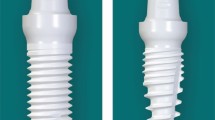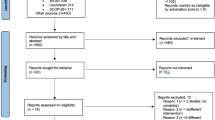Abstract
Design A single-centre (private practice), prospective, longitudinal, split-mouth, single-blind, randomised controlled clinical trial reported peri-implant parameters of individualised abutments bonded to titanium (Ti) bases during a five-year follow-up. The study complied with the ethical principles of the Helsinki Declaration and the CONSORT (Consolidated Standards of Reporting Trials) guidelines. It was approved by the Medical Ethical Committee of the University of Freiburg (013/1630) and registered in the German Clinical Trials Register (DRKS00006163).
Case selection The included subjects had to be over 17 years of age, have an American Society of Anaesthesiologists score of 1, be a non-smoker, have a full-mouth plaque index (PI) below 20%, full-mouth bleeding index (BI) 20%, and planned with at least two dental implants but not adjacent to each other. Participants were excluded if they required simultaneous augmentation, were pregnant or breastfeeding, or had a history of periodontitis. Marginal bone loss (MBL) was the main clinical outcome, while local bleeding on probing (BoP), probing pocket depth (PPD), plaque Index (PI), local recession (REC), and relative attachment level (RAL) were also evaluated. The study timeline consisted of a screening (visit 1) and implant surgery (visit 2). Stage two was three months after implant surgery (visit 3), impression was two weeks after stage two (visit 4), followed up by baseline with a standardised radiograph (visit 5), one-year follow-up with radiographic and clinical parameters (visit 6), two-year follow-up (visit 7), three-year follow-up (visit 8), four-year follow-up (visit 9) and five-year follow-up (visit 10). In total, 24 subjects received two bone-level implants (Conelog, Camlog Biotechnologies, Basel, Switzerland) in the same arch and region up to 1 mm subcrestally. Their implant-abutment connection was an internal 7.5 degree conical connection platform-switch. Each subject received two abutments (one control and one test) as per the split-mouth design. The control abutments consisted of individualised, one-piece, computer-aided design/computer-aided manufacturing (CAD/CAM) titanium abutments, whereas the test abutments were CAD/CAM titanium abutments bonded to Ti-bases. The decision which implant was restored and in which way was made by a coin flip. The surgeon, patient and prosthodontist were blinded regarding the treatment allocation.
Data analysis Descriptive measures and quantitative parameters were obtained from means, standard deviations, minimum and maximum values and 95% confidence intervals. The means of clinical parameters (six sites per implant) were MBL, BoP, PPD, PI, REC, and RAL. Paired t-tests were used for intragroup comparisons at different intervals as well as for intergroup comparisons within each time point. All data collected were considered until participants dropped out (that is, intention-to-treat principle). The significance level alpha was set to 0.05. The post-hoc power calculation of the MBL intergroup comparison dammed this trial as underpowered (power = 34%).
Results All implants were osseointegrated after the healing stage and no implants were lost during the trial. Two subjects dropped out (one after the two-year follow-up and the other at the last appointment). Regarding MBL, no significant intergroup differences were found between the abutment groups. Nonetheless, significant intragroup differences were found at several visits (visit 6 to visit 10) compared to the baseline MBL (visit 5), indicating continuous bone level alterations. Concerning the BoP, no significant differences were identified. In terms of PPD, significant intergroup differences were found at visits 9 (p = 0.006) and 10 (p = 0.024), favouring Ti-base abutments. There were significantly intergroup differences in terms of REC (p = 0.014) at visit 10, with higher values in the one-piece abutment group. No differences were found in terms of PI.
Conclusions A preliminary conclusion of this underpowered trial was that Ti-base abutments have a similar long-term effect to one-piece abutments on human peri-implant tissues.
This is a preview of subscription content, access via your institution
Access options
Subscribe to this journal
Receive 4 print issues and online access
$259.00 per year
only $64.75 per issue
Buy this article
- Purchase on Springer Link
- Instant access to full article PDF
Prices may be subject to local taxes which are calculated during checkout
Similar content being viewed by others
References
Pjetursson B E, Zarauz C, Strasding M, Sailer I, Zwahlen M, Zembic A. A systematic review of the influence of the implant-abutment connection on the clinical outcomes of ceramic and metal implant abutments supporting fixed implant reconstructions. Clin Oral Implants Res 2018; 29: 160-183.
Parpaiola A, Norton M R, Cecchinato D, Bressan E, Toia M. Virtual abutment design: a concept for delivery of CAD/CAM customized abutments- report of a retrospective cohort. Int J Periodontics Restorative Dent 2013; 33: 51-58.
Song F, Koo H, Ren D. Effects of Material Properties on Bacterial Adhesion and Biofilm Formation. J Dent Res 2015; 94: 1027-1034.
Hayashi J, Shimada Y, Tagami J, Sumi Y, Sadr A. Real-time Imaging of Gap Progress During and After Composite Polymerization. J Dent Res 2017; 96: 992-998.
Cairo F, Sanz I, Matesanz P, Nieri M, Pagliaro U. Quality of reporting of randomized clinical trials in implant dentistry. A systematic review on critical aspects in design, outcome assessment and clinical relevance. J Clin Periodontol 2012; 39: 81-107.
Schulz K F, Grimes D A. Generation of allocation sequences in randomised trials: chance, not choice. Lancet 2002; 359: 515-519.
Gigandet M, Bigolin G, Faoro F, Bürgin W, Brägger U. Implants with original and non-original abutment connections. Clin Implant Dent Relat Res 2014; 16: 303-311.
Fokas G, Ma L, Chronopoulos V, Janda M, Mattheos N. Differences in micromorphology of the implant-abutment junction for original and third-party abutments on a representative dental implant. J Prosthet Dent 2019; 121: 143-150.
Rizvi N, Alyahya Y, Rizvi A, Narvekar U, Petridis H. Accuracy of Original vs. Non-Original Abutments Using Various Connection Geometries for Single Unit Restorations: A Systematic Review. J Prosthodont 2022; DOI: 10.1111/jopr.13464.
Igarashi K, Afrashtehfar K I, Schimmel M, Gazzaz A, Brägger U. Performance of a repair service set for the retrieval of fractured abutment screws: a pilot in vitro study. Int J Oral Maxillofac Implants 2019; 34: 567-573.
Igarashi K, Afrashtehfar K I. Clinical assessment of fractured implant abutment screws: The Bernese silicone replica technique. J Prosthet Dent 2018; 119: 717-719.
Afrashtehfar K I, Schimmel M. Muscular activity may improve in edentulous patients after implant treatment. Evid Based Dent 2016; 17: 119-120.
Afrashtehfar K I, Brägger U, Hicklin S P. Reliability of Interproximal Bone Height Measurements in Bone-And Tissue-Level Implants: A Methodological Study for Improved Calibration Purposes. Int J Oral Maxillofac Implants 2020; 35: 289-296.
Afrashtehfar K I, Afrashtehfar C D. Lack of association between overload and peri-implant tissue loss in healthy conditions. Evid Based Dent 2016; 17: 92-93.
Afrashtehfar K I, Katsoulis J, Koka S, Igarashi K. Single versus splinted short implants at sinus augmented sites: A systematic review and meta-analysis. J Stomatol Oral Maxillofac Surg 2021; 122: 303-310.
Afrashtehfar K I. The all-on-four concept may be a viable treatment option for edentulous rehabilitation. Evid Based Dent 2016; 17: 56-57.
Brägger U, Krenander P, Lang N P. Economic aspects of single-tooth replacement. Clin Oral Implants Res 2005; 16: 335-341.
Joda T, Gintaute A, Brägger U, Ferrari M, Weber K, Zitzmann N U. Time-efficiency and cost-analysis comparing three digital workflows for treatment with monolithic zirconia implant fixed dental prostheses: A double-blinded RCT. J Dent 2021; 113: 103779.
Afrashtehfar K I. Conventional free-hand, dynamic navigation and static guided implant surgery produce similar short-term patient-reported outcome measures and experiences. Evid Based Dent 2021; 22: 143-145.
Afrashtehfar K I, Bryant S R. Understanding the Lived Experience of North American Dental Patients With a Single-Tooth Implant in the Upper Front Region of the Mouth: Protocol for a Qualitative Study. JMIR Res Protoc 2021; DOI: 10.2196/25767.
Afrashtehfar K I, Assery M K A, Bryant S R. Aesthetic Parameters and Patient-Perspective Assessment Tools for Maxillary Anterior Single Implants. Int J Dent 2021; 2021: 6684028.
Author information
Authors and Affiliations
Ethics declarations
The authors declare no conflicts of interest.
Rights and permissions
About this article
Cite this article
Afrashtehfar, K., Weber, A. & Abou-Ayash, S. Titanium-base abutments may have similar long-term peri-implant effects as non-bonded one-piece abutments. Evid Based Dent 23, 134–135 (2022). https://doi.org/10.1038/s41432-022-0835-9
Received:
Accepted:
Published:
Issue Date:
DOI: https://doi.org/10.1038/s41432-022-0835-9
This article is cited by
-
Lack of keratinized mucosa increases peri-implantitis risk
Evidence-Based Dentistry (2023)



